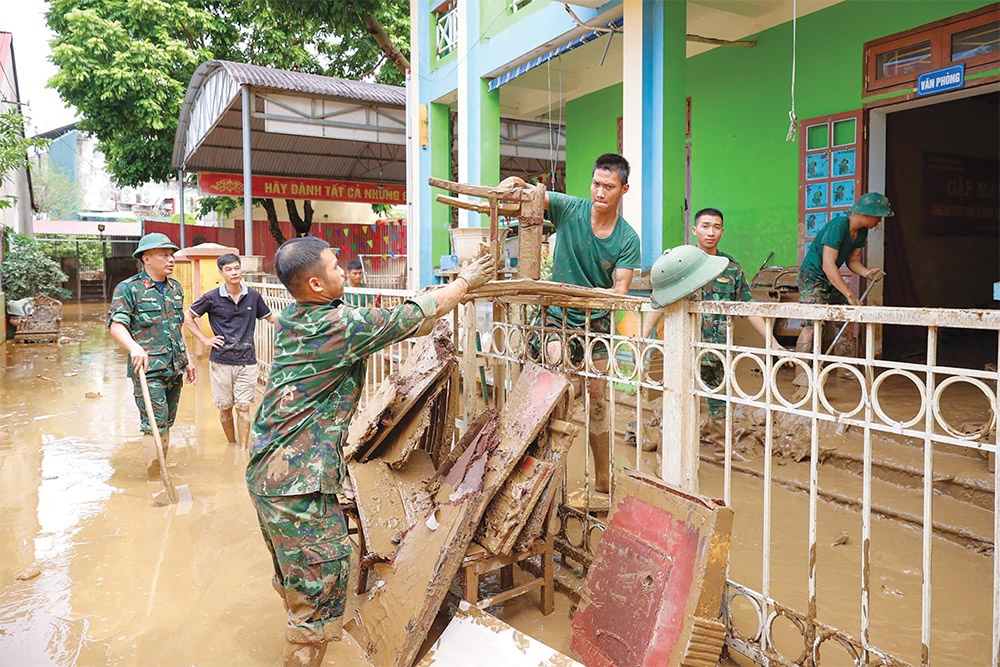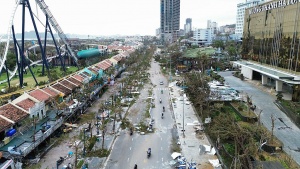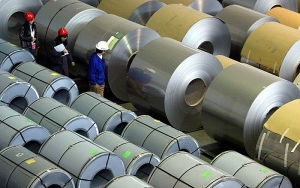Hanoi endures widespread impact from Typhoon Yagi
Although Yagi directly hit Hanoi on September 7-8, its effects on livelihoods persisted after the storm dissipated. By September 12, the Hanoi Construction Department reported over 20,000 fallen trees citywide. Traffic congestion also occurred, with a 10km jam reported on Thang Long Boulevard, one of Hanoi’s main expressways, on the morning of September 9.
 |
| A massive rescue and relief mission has been undertaken to help residents affected by flooding, Photo: Nhat Bac |
The typhoon also affected business infrastructure. On September 7, strong winds blew off the entire metal roof of Thuong Dinh Shoe Company in Thanh Xuan district. Construction companies like Vietnam Export Import Construction Corporation and Hanoi Construction Corporation also reported damage to equipment and infrastructure at their sites.
Thanh Huong, owner of a machinery workshop in Thanh Tri district, said, “Strong winds and heavy rain after the night of September 7 blew off the metal roof of the workshop area, and all electronic systems inside were soaked. It only took us a few days to repair the workshop area, but the operation of products from the workshop is estimated to be delayed by at least a month.”
Heavy post-typhoon rains caused the Red River’s water levels to rise, leading to repeated flood warnings. As reported by the National Centre for Hydro-Meteorological Forecasting, the water level of the Red River peaked at 11.3 metres on September 11, surpassing warning levels not seen in over a decade.
Hanoi authorities banned all vehicle traffic on Long Bien Bridge from 3pm on September 10 until the afternoon of September 13. Meanwhile, on September 11, Bac Tu Liem District Police set up 14 checkpoints, operating 24/7 at the dyke gates to control access. As of September 12, several dyke gates in Bac Tu Liem district were blocked to ensure safety.
Along with rising Red River levels, from September 10-12, many households around the Red River dyke area faced severe flooding, power outages, water shortages, and even temporary relocation.
On September 12, authorities evacuated all residents from the mudflats of the Red River, and thousands of households in Bac Tu Liem, Tay Ho, and Hoan Kiem districts were also relocated.
Tay Ho resident Pham Tuoi told VIR, “Our family was sleepless all night, anxious about the rising water flooding our house while the area lost power. With elderly and young children, we evacuated by noon on September 11. Although power was restored the next day, the water is receding slowly, and our belongings are still scattered at the evacuation site, so we can’t move back yet.”
To address post-typhoon consequences, Hanoi authorities have implemented multiple solutions. In response to residents’ demand for essential goods, Hanoi Industry and Trade Department announced that management agencies have directed commercial businesses and market units to strengthen connections and seek additional supply sources, particularly for vegetables, to ensure an uninterrupted supply.
On September 12, Chairman of Hanoi People’s Committee Tran Sy Thanh instructed functional forces to focus on post-storm recovery, ensuring the city’s dyke system, and safeguarding lives of residents in areas outside river embankments.
Meanwhile, the committee has directed efforts to address fallen and toppled trees across the city. According to preliminary evaluation by the Hanoi Construction Department, around 1,900 of the 8,700 fallen trees in urban areas can be restored.
Typhoon Yagi also caused severe damage in provinces within the northern Vietnam’s key economic region and the mountainous provinces of northern Vietnam. Quang Ninh and Haiphong reported serious damage to infrastructure and social life after the typhoon. The provinces of Thai Nguyen, Yen Bai, and Lao Cai, and Cao Bang experienced flooding and landslides, resulting in deaths and significant losses to crops.
As of the morning of September 13, northern provinces have recorded over 330 people dead and missing due to the typhoon, with Lao Cai and Cao Bang recording the highest casualties, according to the Vietnam Disaster and Dyke Management Authority under the Ministry of Agriculture and Rural Development.
Prime Minister Pham Minh Chinh has directed cities and provinces to address the damage, while international organisations like UNICEF and countries such as Australia, Japan, and the US have mobilised aid for Vietnam.
| Laura Collins, Australian tourist, 45 years old During Typhoon Yagi, my experience was quite intense. I noticed many trees were broken or uprooted. The widespread debris from uprooted trees and damaged structures made travelling around the city hazardous. The streets around Hoan Kiem Lake, which are typically bustling with both locals and tourists, were overwhelmed by debris from fallen trees and damaged infrastructure. Public transport was also affected; I had difficulty catching a taxi or bus because many routes were blocked or rerouted. The usually smooth flow of traffic in the area was replaced by a chaotic scene of stalled vehicles and frustrated commuters. Despite the damage caused by the typhoon, local communities showed resilience and cooperation. People were quick to assist one another, clearing debris and navigating through the challenging conditions. Lin Xiao Yu, Chinese tourist, 23 years old As a foreign tourist experiencing Typhoon Yagi in Hanoi, I had memorable and sometimes stressful experiences. I learned about the typhoon about three days before it made landfall, through warnings from weather apps on my phone and local news. I immediately prepared by buying extra dry food, water, and flashlights. I had planned to travel to Cat Ba for sightseeing but was forced to cancel. Instead, I spent more time in cafés, where I had the opportunity to chat with locals and learn more about how they deal with natural disasters. Many streets were flooded, and some public transportation services were disrupted. However, I received dedicated support from the hotel staff. They not only provided updated information but also helped arrange safe transportation for us when necessary. After the typhoon passed, the provinces we had planned to visit next, Haiphong and Quang Ninh, were heavily damaged, so I adjusted my travel itinerary to stay in Hanoi to learn more about how the capital recovers after disasters. I participated in some small volunteer activities, helping clean up waste and fallen tree branches after the storm. This gave me an opportunity to connect more deeply with the community and better understand the spirit of the Vietnamese people. Aaishwarya Navankar, Indian tourist, 26 years old I arrived in Hanoi at what was supposed to be the best time of year for tourism, but unfortunately, it coincided with Typhoon Yagi’s landfall. When I heard about the typhoon, I felt worried because this was the first time my family and I had to face such a situation. The hotel where we were staying sent timely notices and instructions on how to cope, from stockpiling food to finding safe shelter if the situation worsened. Immediately, my family and I decided to buy more food, water, and always pay attention to our phones to follow warnings from the hotel and local authorities. After Typhoon Yagi passed, Hanoi was still in chaos. We witnessed city workers and rescue teams working tirelessly, trying to clean up debris and fallen trees from the night before. Thanks to the relentless efforts of rescue forces and sanitation workers, many main roads were quickly cleared within hours after the storm. Despite facing many difficulties, I was impressed with how the Hanoi authorities and people here cooperated closely in dealing with the aftermath of the storm. The community spirit and mutual help were evident in their clean-up and relief actions, making me deeply feel the unity and resilience of this city. Amelia Coulibaly, French tourist, 24 years old I had been so excited to explore the city’s famous landmarks and streets, but the storm threw a wrench in my plans. The heavy rain and strong winds made getting around a challenge. Many of the places I wanted to see were either closed or challenging to reach, so I had to adjust my expectations. I also had to regularly check weather apps and local news to stay on top of the storm’s progress and any warnings. Although the weather disrupted my sightseeing plans, it was fascinating to see how the city handled the storm. The locals were incredibly resilient, and their ability to keep going despite the conditions was impressive. Daniel Anderson, American tourist, 24 years old According to my initial schedule, I was supposed to fly into Noi Bai Airport in Hanoi on September 7. However, due to the severe impact of Typhoon Yagi, my flight was cancelled, and I had to reschedule for the following day. On the way from Noi Bai Airport to my hotel, I saw rows of trees leaning over, some even falling across the road, making it difficult for traffic. Broken street lights, houses with damaged roofs, and scattered advertising boards lined the streets. When I arrived in Hoan Kiem district, I was truly surprised by the scene there. Many trees had fallen, especially the large ancient ones around Hoan Kiem Lake and the cathedral. I genuinely feel sorry for the people of Vietnam. In the following days, calling for taxis or other transport was quite difficult; I had to wait a long time for a ride. I had planned to experience a cyclo tour around Hanoi’s Old Quarter, but because of the damage, I had to miss out on this experience. Though I didn’t get to see Hanoi’s beauty as it is often portrayed in the media, this was still an incredibly memorable experience for me. I will definitely return here in the future, and I hope the country will recover and grow stronger than before. Johan Miller, Canadian tourist, 26 years old Before the typhoon, hotel staff advised me not to go outside due to the dangerous conditions. All day Saturday, as the storm swept through Hanoi, I stayed in my room and monitored the weather. Perhaps because my hotel was located in the central area of Hanoi, it felt relatively safe, but the strength of the storm still made me quite anxious. The wind and rain were loud, and the trees were swaying violently. The next morning, after the storm had passed, everything looked devastated. However, I was impressed by how people came together to recover from the aftermath of the storm. Vietnamese people are truly united, always ready to support one another in any situation. The local authorities quickly organised street clean-up efforts. Fallen trees, collapsed billboards, and debris were collected. People swiftly reopened their shops and resumed normal life. The storm left many unfortunate consequences for Hanoi and the surrounding provinces, however each time Vietnam faces such challenges, it impresses the world with the optimism, resilience, and unity of its people. |
 | Quang Ninh faces $960 million economic hit after Typhoon Yagi Typhoon Yagi is estimated to have cost Quang Ninh province $960 million, accounting for more than half of the national damages during this storm. |
 | Vietnam's logistics sector hardest hit by Typhoon Yagi Vietnam's logistics sector was hit hard by Typhoon Yagi, with 82.4 per cent of businesses facing severe or moderate impacts, according to a new report by CEL. |
 | Super Typhoon Yagi drives steel stock prices up Recent growth in steel stocks is reflecting investor optimism about increased demand for construction materials in the wake of Typhoon Yagi. |
 | SABECO supporting localities hit by Typhoon Yagi Beer giant SABECO is working with the Ho Chi Minh Communist Youth Union (HCYU), local authorities, and partners to support the rebuild of northern provinces following the destruction brought by Typhoon Yagi. |
What the stars mean:
★ Poor ★ ★ Promising ★★★ Good ★★★★ Very good ★★★★★ Exceptional
 Tag:
Tag:
Related Contents
Latest News
More News
- Protect what’s next: towards a future free from meningococcal group B disease (December 05, 2025 | 18:00)
- New ILO report offers policy recommendations for disability inclusion (December 04, 2025 | 15:18)
- Maternal job loss may affect children’s mental health, research shows (December 03, 2025 | 19:11)
- Women lead Vietnam’s shift to climate-resilient agriculture (December 03, 2025 | 19:10)
- Experts highlight unpaid care work as key barrier to gender equality (December 03, 2025 | 15:15)
- Opportunities and inequalities for women workers in Vietnam's garment industry (December 03, 2025 | 09:00)
- Vietjet flights carry love to devastated central region (November 28, 2025 | 11:35)
- New initiative to boost the fight against domestic violence (November 26, 2025 | 10:00)
- South Korea funds IOM relief for Vietnam’s typhoon-affected communities (November 24, 2025 | 15:33)
- AI and human-centred values set to shape the future of HR in Vietnam (November 21, 2025 | 18:04)























 Mobile Version
Mobile Version